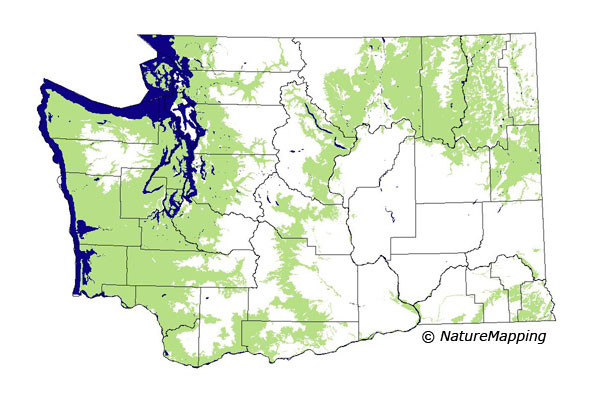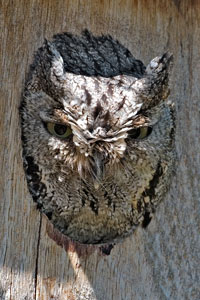

|
Western Screech Owl (Otus kennicottii) 
What they look like: Did you know that some animals can change their color or shape to make themselves look like something else? One animal that can do this is a Screech Owl. When a screech owl gets scared of something, it will stretch its body and tighten its feathers, making it get longer and thinner. Many animals that see this will think that the Screech Owl is just a tree branch, and will leave it alone. This makes these owls hard to find. 
How big they are: Screech Owls are about 8 inches tall, about as long as a brand new pencil, and look a little bit fat. Screech Owls have yellow eyes and gray or brown feathers that are soft and fluffy, and have dark streaks on the lower part of their bellies. They also have pointy ear feathers like a Great Horned Owl - sometimes people think that Screech Owls are baby Great Horned Owls, but Great Horned Owls donít leave the nest until they are full-sized. Where they live: Screech Owls can live in many places. They live in deserts, forests, fruit tree orchards, places with lots of bushes, and neighborhoods like yours. They usually donít live in hills or mountains. Screech Owls build their nests in the holes of hollow trees. Sometimes they take over holes that woodpeckers leave behind. They usually build their nests about as high up as the roof of a one-floor house. A mother Screech Owl will lay 3 or 4 eggs in their nests, and will sit on them for about 26 days, until the baby owls hatch. What they eat: Screech Owls hunt for food at night, when they can see much better than people can. Most owls look for food from a tree branch, but screech owls hunt while they fly around. When they find food, they fly down very, very quietly and catch it. Then they take the food up into a tree and tear it to bits and eat it. Screech owls like to eat little birds, mice, shrews, and other small animals. They will also eat bugs sometimes, but it depends on what time of the year.
Animal silhouettes available to purchase » Photo by Natures Pics Home | About Us | How to Participate | Biodiversity Modules | Projects | Maps | News | Resources |